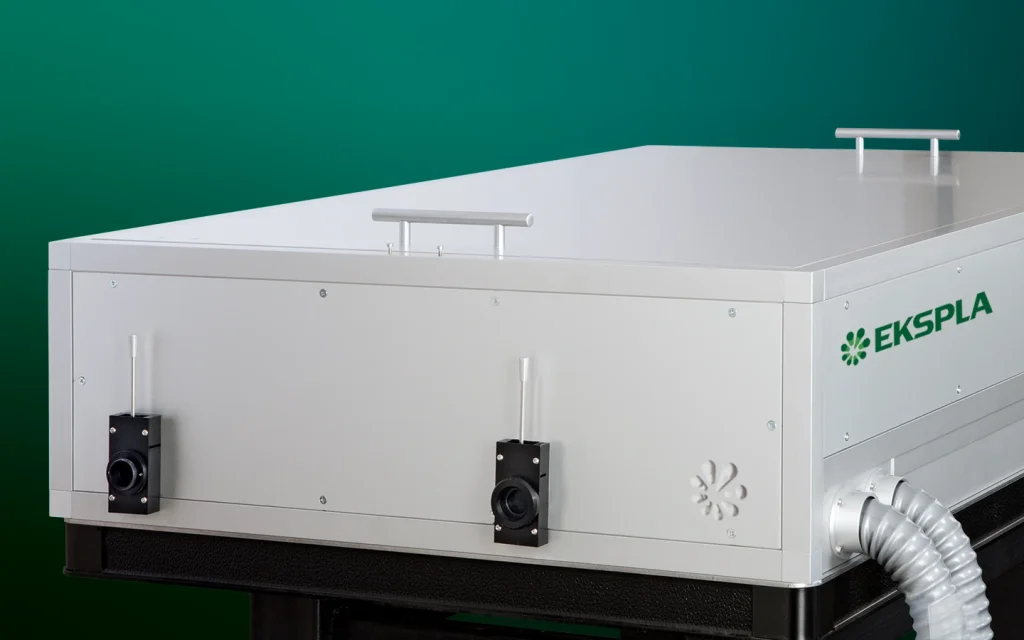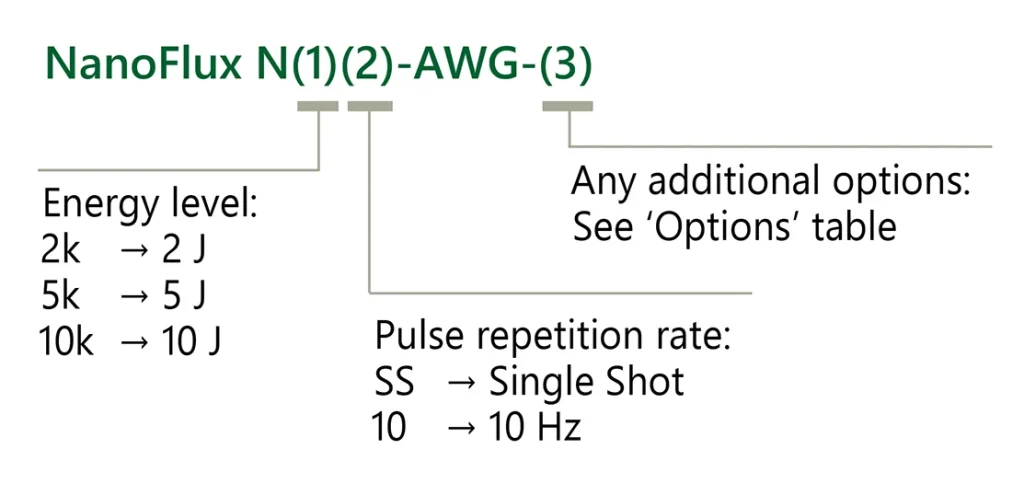NanoFlux AWG series
Temporally Shaped (AWG) High Energy Nd:YAG Lasers
The main laser feature is the ability to shape output pulses temporally which is accomplished by an electro-optical modulator driven by programmable arbitrary waveform generator (AWG).
Features
- High energy nanosecond lasers
- Temporally shaped pulses
- Up to 10 J pulse energies
- 10 Hz pulse repetition rate
- Arbitrary waveform generator for pulse shaping
- 0.15 – 500 ns adjustable pulse duration
- Excellent pulse energy stability
- Cost effective flash lamp pumped power amplifier
- Optional temperature stabilized harmonics options
- Super-Gaussian beam profile
Applications
- OPCPA pumping
- Front end for power amplifiers
- Ti:Sapphire pumping
- Laser peening – material hardening by laser-induced shock wave
- Plasma and shock physics
Description
The main laser feature is the ability to shape output pulses temporally which is accomplished by an electro-optical modulator driven by programmable arbitrary waveform generator (AWG).
The front end of NanoFlux AWG laser system is comprised of a single-mode CW laser which is amplified in a fiber amplifier in the next step. Later on, AWG driven modulator transmits pulses of required temporal shape and duration which are further amplified diode pumped regenerative amplifier or all-in-fiber amplifier in order to reach energies sufficient to amplify in single-pass diode and flash lamp pumped amplifiers. Pulse shaping resolution is 125 ps, while maximum pulse length is 500 ns.
NanoFlux series linear amplifiers are convenient solution for high energy nanosecond systems where pulses are amplified in a chain of flash lamp pumped amplification units up to required energy. During amplification spatial beam shaping is used in order to get a flat top shaped beam profile without hot spots at the system output.
Angle-tuned non-linear crystals harmonic generators mounted in temperature stabilized heaters are used for second, third and fourth harmonic generation. Harmonic separation system is designed to ensure high spectral purity of radiation and direct it to the output ports.
Specifications
| Model | NanoFlux N2k10-AWG | NanoFlux N5k10-AWG | NanoFlux N10k10-AWG |
|---|---|---|---|
| Main specifications 1) | |||
| Output energy 2) | |||
| at 1064 nm | 1500 mJ | 5000 mJ | 10 000 mJ (2 × 5 000 mJ) 3) |
| at 532 nm 4) 5) | 1000 mJ | 3000 mJ | 6000 mJ |
| at 355 nm 4) | inquire | inquire | inquire |
| Pulse repetition rate | 10 Hz | 10 Hz | 10 Hz |
| Pulse duration 6) | 0.15 – 20 ns | 0.15 – 20 ns | 0.15 – 20 ns |
| Pulse energy stability 7) | |||
| at 1064 nm | ≤ 0.5 % | ≤ 0.5 % | ≤ 0.5 % |
| at 532 nm | ≤ 1 % | ≤ 1 % | ≤ 1 % |
| Long-term power drift 8) | ± 2 % | ± 2 % | ± 2 % |
| Beam spatial profile 9) | Super-Gaussian | Super-Gaussian | Super-Gaussian |
| Beam diameter 10) | ~ 11 mm | ~ 25 mm | ~ 25 mm |
| Beam pointing stability 11) | ≤ 50 µrad | ≤ 50 µrad | ≤ 50 µrad |
| Beam divergence | ≤ 0.5 mrad | ≤ 0.5 mrad | ≤ 0.5 mrad |
| Optical pulse jitter 12) | < 50 ps | < 50 ps | < 50 ps |
| Linewidth | single-mode | single-mode | single-mode |
| Polarization | linear, > 90 % | linear, > 90 % | linear |
| Physical characteristics 13) | |||
| Laser head size (W×L×H mm) | 750 × 1350 × 300 | 700 × 2100 × 300 | 1000 × 2100 × 300 |
| Power supply size (W×L×H mm) | 550 × 600 × 840 – 1 unit 550 × 600 × 670 – 1 unit | 550 × 600 × 1220 – 2 units | 550 × 600 × 1220 – 2 units 550 × 600 × 670 – 1 unit |
| Umbilical length 14) | 5 m | 5 m | 5 m |
| Operating requirements 15) | |||
| Power requirements 16) | 208, 380 or 400 V AC, three phase, 50/60 Hz | 208, 380 or 400 V AC, three phase, 50/60 Hz | 208, 380 or 400 V AC, three phase, 50/60 Hz |
| Power consumption 17) | ≤ 6 kVA | ≤ 9 kVA | ≤ 13 kVA |
| Water supply 17) | ≤ 5 l/min, 2 Bar, max 15 °C | ≤ 8 l/min, 2 Bar, max 15 °C | ≤ 12 l/min, 2 Bar, max 15 °C |
| Operating ambient temperature | 22 ± 2 °C | 22 ± 2 °C | 22 ± 2 °C |
| Storage ambient temperature | 15 – 35 °C | 15 – 35 °C | 15 – 35 °C |
| Relative humidity (non-condensing) | ≤ 80 % | ≤ 80 % | ≤ 80 % |
| Cleanness of the room | ISO Class 7 | ISO Class 7 | ISO Class 7 |
| Model | NanoFlux N2k10-AWG | NanoFlux N5k10-AWG | NanoFlux N10k10-AWG |
|---|
- Due to continuous improvement, all specifications are subject to change without notice. The parameters marked ‘typical’ are indications of typical performance and will vary with each unit we manufacture. Presented parameters can be customized to meet customer‘s requirements. All parameters measured at 1064 nm if not stated otherwise.
- The output energies are measured at 5 ns, rectangular pulse at time domain, FWHM.
- The 10 J energy output is combined of two 5 J channels with vertical and horizontal polarizations.
- Harmonic outputs are optional. Specifications valid with respective harmonic module purchased. Outputs are not simultaneous.
- Second harmonic is available with LBO crystal then the conversion efficiency is increased to 70%. If TH/FH options are orders second harmonic efficiency is reduced to ~50%.
- Variable pulse duration in steps of 125 ps. Standard pulse duration adjustability is between 1-20 ns. Shorter or longer pulse durations are optional. Pulse shaping is possible in the range of 1 – 500 ns.
- Under stable environmental conditions, normalized to average pulse energy (RMS, averaged from 60 s).
- Measured over 8 hours period after 30 min warm-up when ambient temperature variation is less than ±2 °C.
- Super-Gaussian spatial mode of 6-11th order in near field.
- Beam diameter is measured at signal output at 1/e2 level for Gaussian beams and FWHM level for Super-Gaussian beams.
- Beam pointing stability is evaluated as movement of the beam centroid in the focal plane of a focusing element (RMS, averaged from 60 s).
- Optical pulse jitter with respect to electrical outputs: Trig out > 3.5 V @ 50 Ω.
- System sizes are preliminary and depend on customer lab layout and additional options purchased.
- Longer umbilical with up to 10 m available upon request.
- The laser and auxiliary units must be settled in such a place void of dust and aerosols. It is advisable to operate the laser in air conditioned room, provided that the laser is placed at a distance from air conditioning outlets. The laser should be positioned on a solid worktable. Access from one side should be ensured.
- Voltage fluctuations allowed are +10 % / -15 % from nominal value.
- Power consumption and water supply requirements deviate depending on system configuration.
Note: Laser must be connected to the mains electricity all the time. If there will be no mains electricity for longer that 1 hour then laser (system) needs warm up for a few hours before switching on.
Options
| Option | Description | Comment |
|---|---|---|
| – G | Provides a Gaussian-like beam profile | Pulse energies are typically lower in comparison to standard version by 80% |
| – AW | Water-air cooling option | |
| – N20…N500 | Extended AWG pulse durations | Output energies (especially for SHG output) are specified for one pulse duration with square temporal pulse shape |
| Option | Description | Comment |
|---|
Power supply
| Cabinet | Usable height | Height H,mm | Width W, mm | Depth D, mm |
|---|---|---|---|---|
| MR-9 | 9 U | 455.5 (519 1) ) | 553 | 600 |
| MR-12 | 12 U | 589 (653 1) ) | 553 | 600 |
| MR-16 | 16 U | 768 (832 1) ) | 553 | 600 |
| MR-20 | 20 U | 889 (952 1) ) | 553 | 600 |
| MR-25 | 25 U | 1167 (1231 1) ) | 553 | 600 |
| Cabinet | Usable height | Height H,mm | Width W, mm | Depth D, mm |
|---|
- Full height with wheels.
Performance
Drawings
Publications
Spectral pulse shaping of a 5 Hz, multi-joule, broadband optical parametric chirped pulse amplification frontend for a 10 PW laser system
We present a broadband optical parametric chirped pulse amplification (OPCPA) system delivering 4 J pulses at a repetition rate of 5 Hz. It will serve as a frontend for the 1.5 kJ, <150 fs, 10 PW laser beamline currently under development by a consortium of National Energetics and Ekspla. The spectrum of the OPCPA system is precisely controlled by arbitrarily generated waveforms of the pump lasers. To fully exploit the high flexibility of the frontend, we have developed a 1D model of the system and an optimization algorithm that predicts suitable pump waveform settings for a desired output spectrum. The OPCPA system is shown to have high efficiency, a high-quality top-hat beam profile, and an output spectrum demonstrated to be shaped consistently with the theoretical model.



